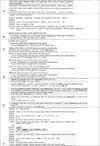Abstract
Backgrounds
Korean bibliographic databases are used to search and retrieve domestic literature for research purposes. However, doubts about their accuracy, completeness, and coverage have been raised since their development and implementation. There have been controversies as to which database is best for searching domestic medical literature. This study was conducted to investigate the usefulness of Korean bibliographic databases in identifying domestic literature related to microbiology and infectious diseases.
Materials and Methods
Four bibliographic databases, including KoreaMed (www.koreamed.org), KISS (kiss.kstudy.com), KMbase (kmbase.medric.or.kr), and RISS (www.riss4u.net), were used for this study. One public bibliographic database, which discontinued its update, and other commercial database services were not evaluated. After performing searches utilizing representative terms related to microbiology and infectious diseases, numbers of retrieved results were compared. The results of bibliographic records gathered by using KoreaMed were compared with those of three other databases; only the journals published from 2001 to 2007 were taken into account.
Results
The number of search results retrieved by using each of the four databases ranged from 3 to 5,444 records depending on the search terms. In general, more search results were identified with KMbase and RISS than with KoreaMed and KISS. The concordance rate of the search results, utilizing the same search terms, between KoreaMed and three other databases ranged from 0% to 93.3%. Bibliographic errors including wrong order of authors, misspelled authors' names, use of the old journal title, and duplicate records were found in all databases.
Conclusions
Total number of results obtained from each of the four Korean bibliographic databases using the same search terms was different and discordant. Researchers are recommended to take into account their characteristics and limitations when using Korean bibliographic databases for medical researches.
Figures and Tables
 | Figure 1Examples of bibliographic errors found in the Korean bibliographic databases. A) Duplicate records, B) Wrong order of authors, C) Misspelled english names, D) Errors in the volume and issue number, E) Misspelled titles, which were incidentally encountered while using an incorrect search term 'staphylococus,'F) Wrong title. The original title of the latter article is 'Evaluation of Morphological Plasticity in the Cerebella of Basketball Players with MRI.' |
Table 1
Characteristics of Korean Bibliographic Databases Used for Medical Research

Adapted from references (16-19).
*Free to institutional members but can be provided to individuals on online payment at other website (www.papersearch.net).
†A photocopy can be provided on payment.
‡Free to institutional members but can be provided to individuals on online payment.
Table 2
Search Results Retrieved from Korean Bibliographic Databases Using Representative Terms Related to Microbiology and Infectious Diseases from Pre-1960s through 2007

References
1. Kim SY. Literature review for research in family medicine. J Korean Acad Fam Med. 2004. 25:428–438.
2. Chi JG. Necessity of searching medical literature. J Korean Med Assoc. 1994. 37:37–38.
3. Doig GS, Simpson F. Efficient literature searching: a core skill for the practice of evidence-based medicine. Intensive Care Med. 2003. 29:2119–2127.

4. Patrick LJ, Munro S. The literature review: demystifying the literature search. Diabetes Educ. 36. 30:30–34. 36–38.

5. Rau JL. Searching the literature and selecting the right references. Respir Care. 2004. 49:1242–1245.
6. Kim HB, Yoon BJ. The prospective study on indexing of medical literature in Korea. J Korean Med Libr Assoc. 1998. 25:71–93.
7. Lee CS. Evaluation of Korean medical journals: a bibliometric analysis. J Korean Soc Inf Manage. 2000. 17:49–65.
8. Jeong EC. What doctors want from a medical library. J Korean Med Libr Assoc. 1998. 25:107–112.
9. Song JY. A Study of effective management of medical information. J Korean Libr Inf Sci Soc. 2002. 33:331–349.
10. Cho HM. Search strategy for identifying medical literature for systematic reviews. J Korean Acad Fam Med. 2006. 27:S83–S88.
11. Cho SY, Rha JG, Park JH, Joung KH, Lee YC. A project for establishment of the Korean National Electronic Library of Medicine. 2005. Seoul: Korea Education and Research Information Service.
12. Kim SJ. Distribution of Korean medical and life science journals. J Korean Med Libr Assoc. 2005. 32:4–27.
13. Park JH. A study of the service management of the Korean National Electronic Library of Medicine. 2006. Seoul: Chung-Ang University.
14. Kim IH. Necessity of a search system for Korean medical journals and of standardization for the first case report. Korean J Dermatol. 2008. 46:7.
15. Kim SJ. Distribution of Korean medical and life science journals. J Korean Med Libr Assoc. 2005. 32:4–27.
16. KAMJE. KoreaMed. Available from:URL: http://www.koreamed.org/Overview.php.
17. KSI. Korean studies Information Service System. Available from:URL: http://kiss.kstudy.com.
18. Korean Medical database. MedRIC. Available from:URL: http://kmbase.medric.or.kr.
19. KERIS. Research Information Service System. Available from:URL: http://www.riss4u.net.
20. Cho SY. A study on error data types in the KERIS Union Catalog: Focused on dissertation bibliographic database. J Korean Soc Libr Inf Sci. 2002. 36:5–19.

21. Kim HB. Indexing medical citations in KoMCI 2000. KoMCI 2000. 2002. Seoul: Korean Academy of Medical Sciences;21.
22. Lee JH. Improving the circulation of medical information. J Korean Med Libr Assoc. 1998. 25:23–29.




 PDF
PDF ePub
ePub Citation
Citation Print
Print




 XML Download
XML Download